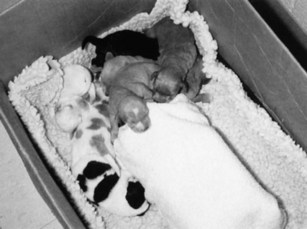CHAPTER 9 Care of the Orphaned Puppy and Kitten
Hand Rearing
Environmental Control
Plastic sweater boxes work very well as nesting boxes; heating pads can be set on low under a portion of the box. This will limit the risk of moisture conducting heat from the electric heating pad, inducing significant burns of the neonates. One drawback of plastic or glass containers is that they are not absorbent, so care should be taken to deal with any fluids that may end up in the box. Some caregivers advocate locating the nesting box at table height, since neonates receive closer attention if caregivers do not have to bend over (Figure 9-1). Nesting boxes should not be placed near heating vents or air conditioning ducts.
Requirements for strict temperature control are particularly needed when there is a single orphan. When there are multiple neonates, they will huddle together to preserve their heat. Neonates in the first week of life need an incubator-like environment with temperatures approximately 85° to 90° F (29° to 32° C). The nesting box temperature can then be dropped to 80° F (26.5° C) for the next 3 to 4 weeks (Table 9-1).
TABLE 9-1 Environmental temperatures for neonates
| Age in days | Nesting box temperature | Normal neonatal body temperature |
|---|---|---|
| 0-7 | 85° F (29° C) | 96-98° F (35.5° C-36.5° C) |
| 8-28 | 80° F (26.5° C) | 99° F (37° C) |
| 29-35 | 75° F (24° C) | 100.5° F (38° C) |
| 35+ | 70° F (21° C) | 100.5° F (38° C) |
Stay updated, free articles. Join our Telegram channel

Full access? Get Clinical Tree



 to 5 weeks of age and are much more ambulatory, the use of a child’s plastic swimming pool works well as a housing solution. These pools are inexpensive and easily cleaned. Additionally, standard-sized folding exercise pens will fit firmly around the pool, keeping the puppies contained. Rubber-backed floor mats with close cloth nap work well as bedding, providing excellent footing and warmth. These are easily removed and cleaned, and when used as a pair, can be rotated so while one is in use the other is being cleaned and dried.
to 5 weeks of age and are much more ambulatory, the use of a child’s plastic swimming pool works well as a housing solution. These pools are inexpensive and easily cleaned. Additionally, standard-sized folding exercise pens will fit firmly around the pool, keeping the puppies contained. Rubber-backed floor mats with close cloth nap work well as bedding, providing excellent footing and warmth. These are easily removed and cleaned, and when used as a pair, can be rotated so while one is in use the other is being cleaned and dried.